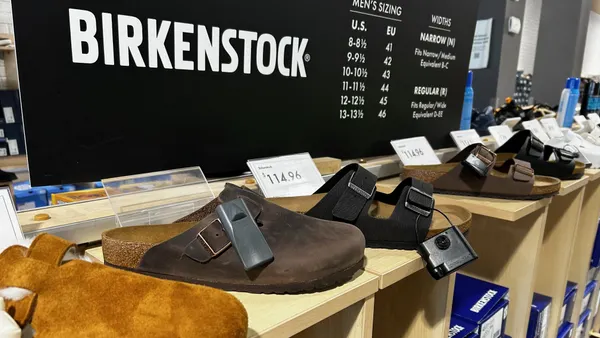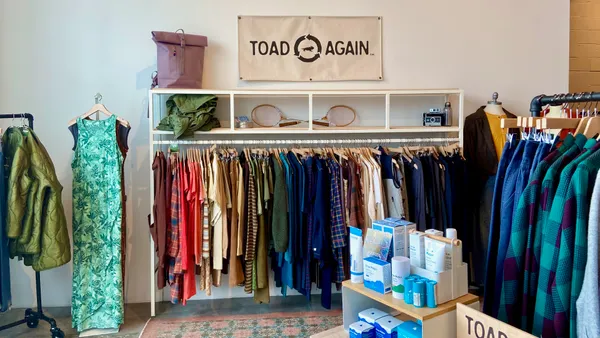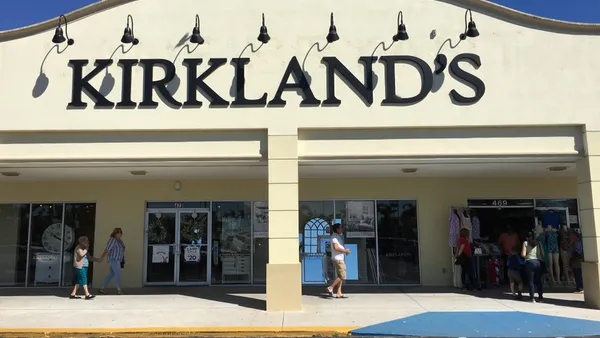Dive Brief:
-
Designer Brands on Wednesday reported that third quarter net sales fell 30.1% year over year to $652.9 million. Online sales rose 3%, executives said during their earnings call, according to a transcript from Seeking Alpha.
-
Comparable sales fell 30.4%, compared to the 0.3% increase in the year-ago period, according to a company press release. Executives said they will likely end up closing 10% to 15% of the store fleet, which in the U.S. could mean about 50 to 80 of the retailer's 524 locations.
-
The retailer swung to a $40.6 million net loss in the quarter from $43.5 million in net income a year ago, with an operating loss of $58.6 million, down from operating profit of $56.1 million. Gross profit contracted by $107.7 million to $165.7 million, with gross margin down to 25.4% from 29.3% last year.
Dive Insight:
Like so many apparel retailers, Designer Brands has been forced to upend its merchandise assortment as people, stuck at home for work and play due to the pandemic, have opted for more casual attire.
With signs of increased demand for boot sales earlier this year, the retailer increased its orders but is now stuck with an excess because that demand waned amid the re-escalation of the pandemic, executives told analysts.
"We are aggressively managing inventory to align product on hand with current demand trends," CEO Roger Rawlins said. "However, if the COVID resurgence holds steady or worsens as we move through the fourth quarter, we will likely need to take further markdowns on some of the seasonal boot product that we bought following the initial signs of demand we discussed earlier."
It's the flip side of the inventory challenges the pandemic has presented to retailers, which in some cases have led to lean inventories that helped some actually boost their margins this year. For Designer Brands, inventory management was made all the more difficult in the period due to a vendor ransomware attack that affected the quarter's performance.
The retailer is faring better with its decision to expand its athleisure assortment to 49% of its offer, up from its usual 28%, Rawlins told analysts. "Our performance metrics in the U.S. retail support the increased penetration in athletic, with athletic comps up 5% for the quarter, significantly better than non-athletic comps that were down 40% during the same timeframe and even stronger than last year's level of 4%," he said, noting that margins in the category were "up roughly 300 basis points versus last year, while margins in non-athletic are down over 600 basis points."
The retailer is in the midst of a three-year strategic plan that included the introduction of nail salons and shoe repair services into its stores. That's turning out to be poor timing, as the pandemic's recent upsurge is keeping customers out of stores. The company noted in its release that the "decrease in gross profit was primarily driven by the significant reduction in customer traffic with the continuing impact of COVID-19."
After some recovery at the end of the summer, store traffic is back down around 40% in the current quarter, Rawlins said. Meanwhile, Designer Brands, once known as DSW, hasn't had much success shifting sales online, with William Blair analyst Dylan Carden in emailed comments noting that its 3% growth falls behind peers.
Chief Financial Officer Jared Poff said the company is pursuing aggressive lease negotiations, but that it's "likely" that 10% to 15% of the fleet will close for good. During the third quarter, the retailer opened four stores and closed two in the U.S., resulting in a total of 524. A reduction on that scale would entail the closure of 50 to 80 U.S. locations.
The merchandising pivots and fleet reduction introduce further unknowns, especially since it's unclear when the promise of a coronavirus vaccine will be fulfilled, according to William Blair analysts.
"[W]hile we believe a smaller footprint will be beneficial for the company in the long term, the store closures could drive additional volatility in expectations ahead of the first half of 2021," they wrote. "We see additional risks from longer-term disruptions related to the pandemic and increasing competition in the athletic footwear category."















